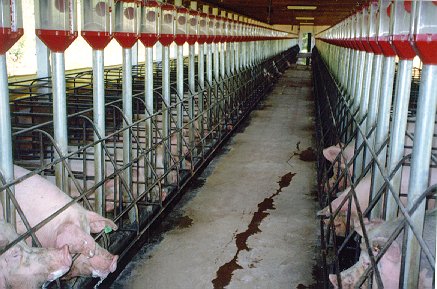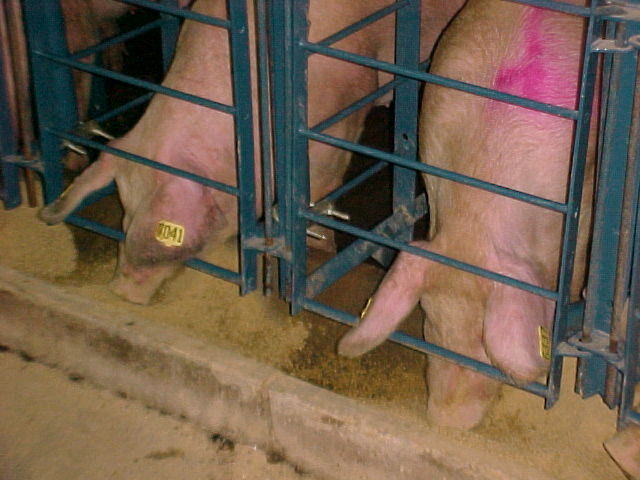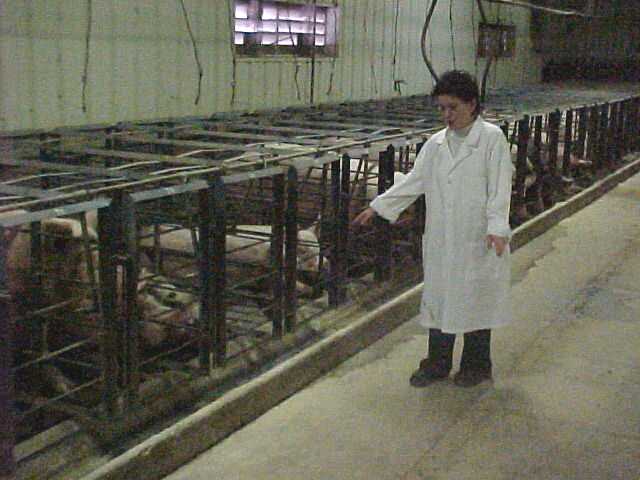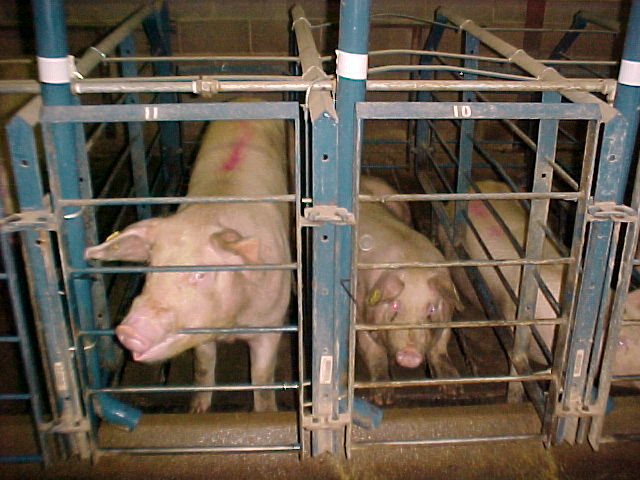An Overview the Current Status of and Options
Current Status of Housing and Penning Systems for Sows
Sow housing in the broadest sense refers to how sows are kept. Sows may be kept indoors or outdoors in a variety of systems. Penning with indoor or outdoor systems differ substantially. Outdoors, sows are almost never kept in crates or stalls but rather in pens or pastures of various sizes that allow social grouping. Indoors, sows may be kept in individual crates, stalls or tethers or in pens of various sizes.
Reasons for choice of a sow housing or penning system include the preferences of the pork producer, economics, legal requirements, geographic location and welfare of the sows. The leading reason for choice of a housing and penning system is the economic pressures on the pork producer.
This report attempts to objectively summarize, in lay terms, the current status of housing and penning systems for gestating sows (and gilts). Because economic forces play so heavily on decisions about housing and penning systems, and because the percentage of sows in crates has increased significantly over the last half of the 20th century, this report begins with a summary of recent USA swine industry restructuring. Then, common housing and penning systems for sows are discussed.
Recent Swine Industry Restructuring
The late 1990's will be characterized in the history of the pig industry as a time of major restructuring. The decline in number of farms having pigs over the last 5 decades of the 20th century was accelerated in the 1990s. The accelerated trend for farms getting larger (in terms of pig inventory) is matched with the numbers of farms rapidly declining. In 2000, over 50% of the USA pigs are housed on the 50 largest farms. To see a list of the largest farms in North America, click on:
http://www.agriculture.com/sfonline/sf/2000/october/0011powerhouses.html
Further consolidation is expected.
As consolidation continues, farms get larger, capturing additional economies of scale and market share. Large farms can afford greater environmental controls, they can purchase inputs at a reduced rate (especially grain) and they will have a lower cost of production. Large-scale corporate farms are typically slightly less productive than well-managed smaller farms, but they are much more productive than the average productivity of smaller farms.
The changes in the swine industry in recent years include loss of numbers of farms and pork producers. Fewer, larger farms are found in the USA inventories (Table 1). At the same time that the sow herd is declining in size, the total pigs marketed is increasing (Table 1). A smaller sow herd, with greater pig output per farm, is a testament to the restructuring that is rapidly underway.
The increase in pigs marketed in recent years was absorbed by an increase in USA pork exports. Associated with the impressive increase in pigs marketed was large swings in the open market price paid to independent pork producers. The low prices received by pork producers in late 1998 through 1999 had a very negative effect on independent pork producers while vertically integrated pork producers were less negatively affected. Future very low prices for market hogs in the USA will further test the sustainability of smaller farms but is not expected to be a concern for vertically integrated pork producers who can capture consumer dollars further up the pork chain.
Table 1. Restructuring of the USA pig and pork industry in recent years.
|
Year |
Number of Farms |
Total USA Number of Sows, thousands |
Total USA Pigs Marketed, thousands |
|---|---|---|---|
|
1990 |
275,440 |
6,847 |
89,240 |
|
1992 |
249,500 |
7,102 |
98,589 |
|
1994 |
208,780 |
7,415 |
101,121 |
|
1996 |
157,450 |
6,663 |
101,468 |
|
1998 |
114,380 |
6,672 |
117,240 |
|
1999 |
98,460 |
6,244 |
121,187 |
Sources: USDA Hog and Pig Reports
One geographic area showing recent growth in pig numbers is the Southern high plains of West Texas, Western Oklahoma, Southwestern Kansas, and Eastern Colorado. Over 300,000 sows and 6 million market hogs were added to the Southern high plains inventory in the last 8 years. Over 95% of these sows are housed indoors in gestation and farrowing crates.
Economic pressures on pork farms require that they use technologies that are the most efficient. Once a building is built, the most efficient use of space will be to have as many units of production in that building as is possible.
The sow crate allows the greatest number of sows per unit of space.

In Texas, the sow herd size is remaining constant while the number of pigs marketed is rising. The constant sow herd size is attributed to an almost equal exchange of loss of sows on small farms with an increase of sows on large farms. The “newer” sows are on farms that are more productivity, therefore more pigs are being marketed per sow and per farm. In the near future, the sow herd is again expected to rise. The next cycle, however, the sow numbers will rise and the pigs marketed will rise proportionally higher.
The trend is expected to continue with announced expansions by local large-scale producers in the years 2002-2003
For new farms built around the country, the gestation and farrowing crates are by far the most common housing system for sows. Rapid industrialized, restructuring of the pork industry has accelerated adoption of the crate as the standard housing system in the USA.
For a summary of pork industry statistics see USDA's National Animal Health Monitoring Service web page, found at:
http://www.aphis.usda.gov/vs/ceah/cahm/Swine/swine.htm
What is a Gestation Crate (or stall)?
The crate (sometimes called a stall) is a simple pen made of metal that contains the sow in the least possible space that is economically feasible. Most crates measure 2 feet (l6 m) wide by 7 feet (2.1m) long.


Sows housed in a crate cannot turn around, but they can stand up and lie down and take one step forward or backward. They can eat freely. Researchers have documented that sows in crates do not have enough room to freely stand up and lay down without touching the crate walls (Curtis et al., 1989). Curtis further documented that the standard crate (2' x 7') is larger than the average sow's body size. Thus, the crate is large enough to contain the sow, but the crate does not provide enough room for normal postural adjustments. The space that a given sow has can be observed by opening the crate front. The picture below was taken from the open front gate of a crate. Note the feet of neighbors overlap (on lower left) with the main sow in the picture. Likewise, sows are able to perform some simple social interactions through the bars.
Use of the gestation crate is driven by two primary factors:
- Economics: The more sows per building one can have, the lower the building costs would be for the farm.
- Sow Welfare: The crate eliminates most social stress and allows for individual feeding of sows based on their individual needs.
If sow welfare was the only factor in designing the crate, then crates would be much larger (perhaps twice the area or more). Once the decision is made to individually house sows to provide individual care, economics will determine the actual space that is provided. Economics drives the space allowance down while animal welfare considerations drive the space up. Furthermore, economics favors use of concrete slatted floors under crated sows rather than solid floor with bedding. Concrete flooring leads to foot lesions and shoulder lesions. Bedding would prevent some skin and limb lesions however removal of bedding and sanitation of a bedded crate is not considered practical by the industry, so the crate is more typically placed on a slatted floor surface rather than a bedded surface.
World-Wide Views of the Sow Crate
Human views, based on science and consumer preference, vary around the globe about the sow crate. In less developed countries use of the sow crate is not an issue. In many countries in Latin America and Asia (even in less-developed countries), sow crates are commonly used on new farms (due to economic considerations). Shown here is a picture of sows in gestation crates in Brazil on a modern pig farm. Virtually the same equipment and pig genetics are used around the world, regardless of stage of the countries economic development and local economic pressures.
Within the European community (EU), countries vary widely in use of sow crates. While tethers (an uncommon system in the USA) are outlawed (and being phasing out) in the EU, the sow crate is not the subject of an EU-wide law or regulation. However, at least three European countries (UK, Sweden, Switzerland) have unilaterally banned the crate while other countries (most notably the Netherlands) are actively seeking an alternative to the sow crate.
In the USA, there are no laws or regulations that restrict or encourage the use of the sow crate. As of the year 2000 there are no market forces that specifically encourage or discourage use of sow crates in the USA. “Natral” pork, for example, can be produced using sows housed in crates. Modern, indoor units sell pork products with the natural label based on the idea that either (a) the animals were not given antibiotics or hormones and/or (b) the pork does not have additives. However, many if not most of these “natural” pork products come from farms that use sows in crates and grow pigs on slotted floors. USA consumer awareness of sow crates is thought to be low, but this is not well documented.
Alternatives to the Sow Crate
While the percentage of sows in crates is arguably rising in the USA, the numbers of alternatives to the sow crate are quite large. Alternatives to the sow crate can be grouped into:
a) Indoor systems
b) Outdoor systems
Within the indoor systems, we see sows housed individually or in groups. Among individual systems are only tethers and crates. With the tether comes serious animal welfare concerns. The tether comes in two forms: girth tether and neck tether. The tether includes a collar or belt that has a chain that is bolted to the side pen wall or to the floor. The sows can move forward or back. Sows in tethers may actually have slightly more room than in crates.
The sow crate design is fairly uniform around the world. The feeder can be made of metal, but more often the sow feeder is concrete. Metal bars are at the front of the crate.
Some sows show repeated bar biting against the front bars. The reasons sows bite, chew, lick and rut the bars and feed trough are not known. The name “bar biting” is not entirely accurate since other substrates may be subjected to the behavior and behaviors other than biting are expressed (ex., chewing, rubbing with the snout).
--- Click here for movie of sow bar biting ---
A more objective term for this is oral-nasal-facial (ONF) behaviors. All sows, even those outdoors, show ONF behaviors. Mechanisms for expression of ONF behaviors are not known. For example, is ONF a normal part of the sow's day? Is ONF a sign of stress? Do management factors (other than stressful conditions) induce ONF behaviors? Answers to these questions are not known.
Indoor sows certainly can be housed in social groups. Group housing of sows is best achieved when they are prevented from dominating one another, especially at feeding times. Common housing systems for group housing of sows include use of feeding stalls, electronic sow feeder systems (ESF) and many other systems.
Many other indoor production systems are available to house sows in social groups. In each indoor group-penning system, an attempt should be made to reduce social stress around feeding by allowing individual feed consumption by use of a feeding stall of some sort. Alternative indoor production systems for sows are not universally accepted as improving sow welfare. While sows can socially interact, they can also injure one another by biting each others vulva and by biting, pushing and riding one another. The only way currently available to reduce social stress among indoor group-housed sows is to provide individual feeding areas and even then behavioral problems are common.
Comparison of Well-Managed Indoor vs. Outdoor Systems
Outdoor housing systems include three general systems: dirt lot (a potential environmental hazard), outdoor with a crop rotation and outdoor sustainable. Putting sows outdoors may solve some animal welfare concerns. Outdoor-housed sows have few problems with social stress and with skin lesions (such as shoulder lesions). The social stress is reduced because of the large amount of space given the sows and due to their ability to get away from boss sows. The skin and joint problems are largely solved because sows are not on concrete flooring. Economic concerns are addressed by use of large spaces with inexpensive equipment (like huts instead of expensive crates).
The main problem with outdoor production systems is that they do not work too well in many climates in which pigs are found. Outdoor production does not work so well, in terms of animal and human welfare, in wet climates or very cold climates. Still, outdoor sow herds are found in England, Scotland, Denmark and Sweden. Interesting tent systems are available for protecting outdoor sows in cold and wet climates.




Outdoor sows in Wyoming (top left)
Outdoor sows in Southern Illinois (top right)
Outdoor sows on a wet Georgia farm (bottom left)
Outdoor sows in a straw tent in the UK (bottom right)
The Challenge of Comparing Housing and Penning Systems
Comparison of sow housing systems is a great challenge. Examining just one feature (ex., behavior) does not paint a complete picture of the production system. At this time, society and pork producers consider nine measures of efficacy of sow housing systems including (not in priority order):
Sow
Human ergonomics (labor quantity and quality)
Worker health and safety
Stress physiology and health
Reproductive performance
Economic competitiveness
Environmental impact
Community impact
Food safety risks
Collecting data on these diverse measures is a challenge. Ignoring any one of the above criteria could lead to slippage in another criteria. For example, adding fiber to the diet of sows to reduce bar biting and sham chewing increases the environmental burden of the farm.
For studies examining indoor and outdoor sows, or sows in crates versus another indoor group system, it is important to obtain young gilts of a contemporary age from a common source and then randomly assign gilts to production systems. This is rarely done in published reports.
Measures of physiology are difficult to obtain in group housed sows without adding a stress associated with the capture and restraint of grouped sows. Individually-penned sows can be fit with remote sampling catheters while group housed sows will remove such devices from their pen-mates.
Measures of animal health and immunity are also difficult to obtain. When keeping sows in diverse systems, their microbial exposure levels can be vastly different. For example, outdoor sows have little respiratory pathogen exposure compared with indoor sows who share a common air space. In some of our studies outdoor pigs' immune systems were lower than indoor pigs. Two conflicting hypotheses emerge: outdoor pigs could be stressed and thus have a lower immune system values or conversely outdoor pigs could have less immune system microbial activation due to a more healthy environment. At this time we are not able to discriminate between these two opposite hypotheses.
Some measures may differ for sows in different systems, but they have little practical significance. For example, if bone strength was to be lower in crated sows than group-housed sows, but the injury rate (broken bones, skin lesions, etc.) was higher among group-housed sows, one might have a difficult time assessing sow welfare.
Finally, from a scientific perspective, when sows are housed in a large social group, the study group is the social group. If one has a study with one electronic sow feeder, for example, the study group is the single pen of sows and the study is not replicated. This makes replication of such studies difficult and costly. Furthermore, if the study group is a single large pen of pregnant sows, then on commercial farms, there would be sows constantly entering and leaving the social group resulting is social distress and study variation compared with sows in individual pens or crates.
Ethical Considerations
In today's well-fed society, ethical standards must be considered. Public perception is important to consumer acceptance of pork products. Today's consumer is largely out of touch with current pork production practices. A segment might be willing to use their ethical convictions and purchasing power to encourage certain production systems. Other consumers may have different ethical values and may feel a lower price for food is more important to them than a given production system. Consumer ethical values are beginning to influence international trade as well as domestic purchasing decisions. When consumers are making decisions, scientists are looked-to for objective information on which to base ethical decisions. If consumer awareness of production practices grows, our surveys reveal that a majority (but not all) consumers will be willing to pay more for pork products with certain assurances (animal welfare, environmental and perhaps others). When this day arrives, it is important that pork producers have information to allow them to implement alternative production systems that provide equal or better animal welfare and at the same time do not cause other problems (such as environmental or food safety problems).
Literature Cited
Curtis, S.E., Hurst, R.J., Gonyou, H.W., Jensen, A.H., and Muehling, A.J. The Physical space requirement of the sow. J. Anim. Sci. 67 (1989): 1242-1248.
United States Census of Agriculture, 1950, Volume 5, Part 5. US Bureau of Agricultural Economics.
Laboratory of Animal Behavior, Physiology and Welfare
-
Address
1308 Indiana Ave Lubbock, TX 79409-2141 -
Phone
806.834.8275 -
Email
john.mcglone@ttu.edu

